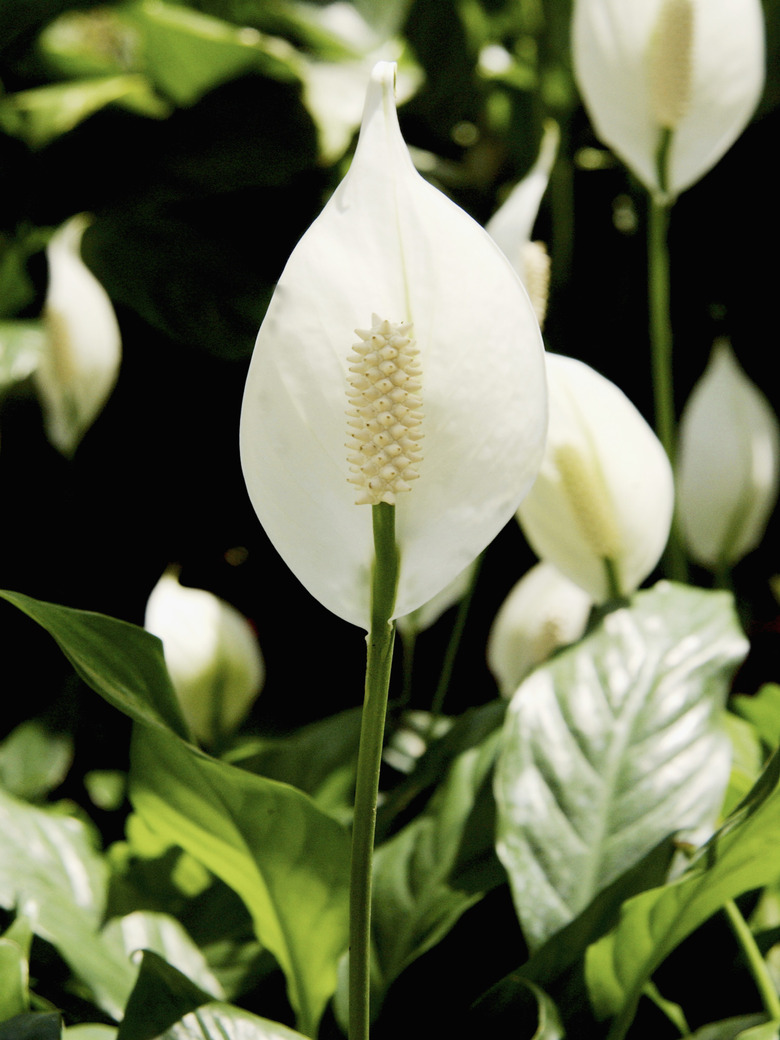What Are The Causes Of The Leaf Tips Turning Brown On A Peace Lily?
Step 1
Peace lilies are not true lilies but are related to caladiums, philodendrons and Jack-in-the-Pulpits. Native to the tropical Americas, peace lilies are classified as herbs but grown most commonly as houseplants. Thriving with little care, peace lilies are forgiving of low-light conditions that compromise other plants. Although most peace lilies grow 1 to 4 feet tall, the Sensation variety reaches 6 feet in height and width, according to the Clemson University Cooperative Extension. Their showy white flowers can bloom any time of year.
Water and Humidity
Step 1
Insufficient water is a primary contributor to brown leaf tips on a peace lily. Shallow watering that does not reach the entire root system is insufficient to hydrate peace lilies properly and results in tip dieback. Shallow watering also keeps excess water from draining through weep holes, which allows salts to accumulate in the soil. The peace lily has a high rate of evapo-transpiration, according to the Seminole County Extension Service. This means that too much water is lost through leaves and leaf tips turn brown accordingly. Mist or spray leaves often to increase humidity.
Step 2
- Peace lilies are not true lilies but are related to caladiums, philodendrons and Jack-in-the-Pulpits.
- Native to the tropical Americas, peace lilies are classified as herbs but grown most commonly as houseplants.
Fertilizer
Step 1
Sometimes less is more when applying fertilizer to houseplants. The Clemson University Cooperative Extension recommends using very little fertilizer for peace lilies. When excessive fertilizer builds up in soil, peace lilies may exhibit brown leaf margins, which is a symptom of tip burn. The plants may need to be re-potted if burning is severe. Rinsing the roots thoroughly with water and re-potting in fresh soil will prevent browning on new growth.
Light and Temperature
Step 1
One of the peace lily's desirable traits is its adaptability to low-light conditions. Direct sun, intensified through windowpanes, can burn the plant's leaf tips and subjects it to heat stress. Bright, indirect light is best for optimal growth. Placing plants in light that's bright enough to read a newspaper is the guideline given by the University of Arkansas Cooperative Extension System. Temperatures greater than 90 degrees Fahrenheit can also cause brown leaf tips. Windows with northern or eastern exposures are generally cooler than those with southern or western exposures.
Step 2
- Sometimes less is more when applying fertilizer to houseplants.
- When excessive fertilizer builds up in soil, peace lilies may exhibit brown leaf margins, which is a symptom of tip burn.
References
- Iowa State University Extension: Lily Brings Peace of Mind
- Clemson University Cooperative Extension: Peace Lily
- Seminole County Extension Service: Spathiphyllum — the Peace Lily
- University of Arkansas Cooperative Extension Service: Plant of the Week — Peace Lily
- Alabama Cooperative Extension System: Home Selection and Care of Interior Foliage Plants
